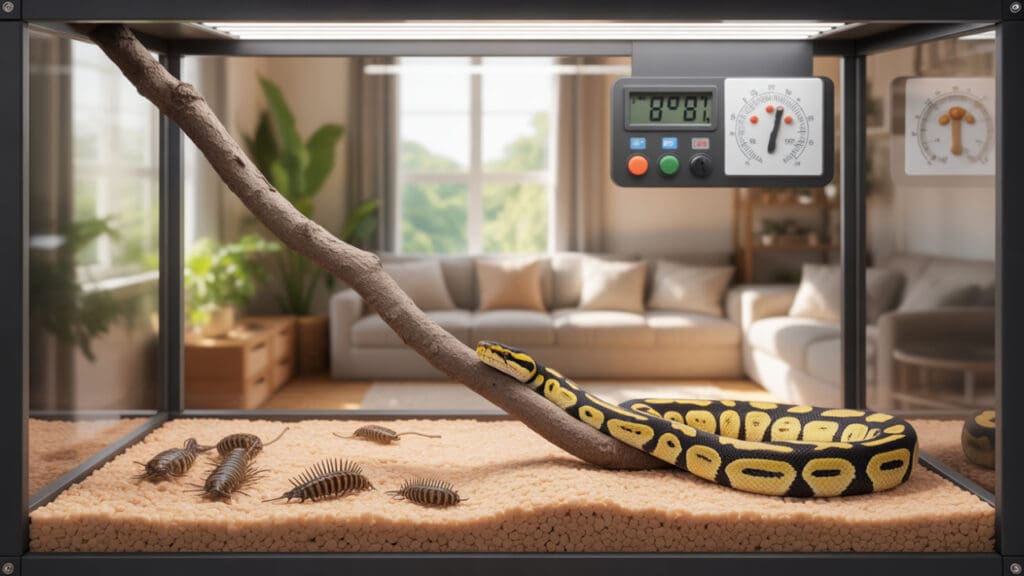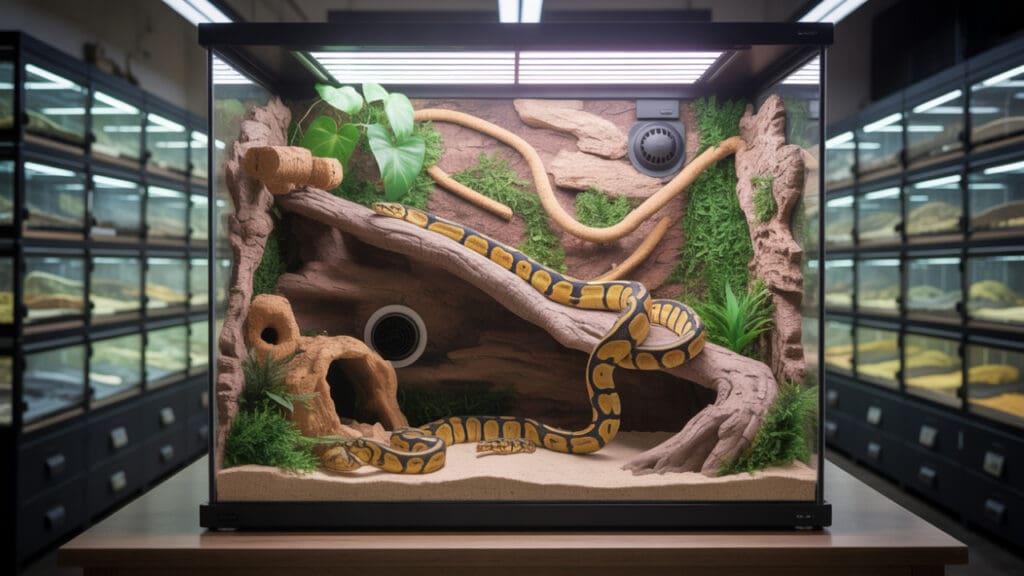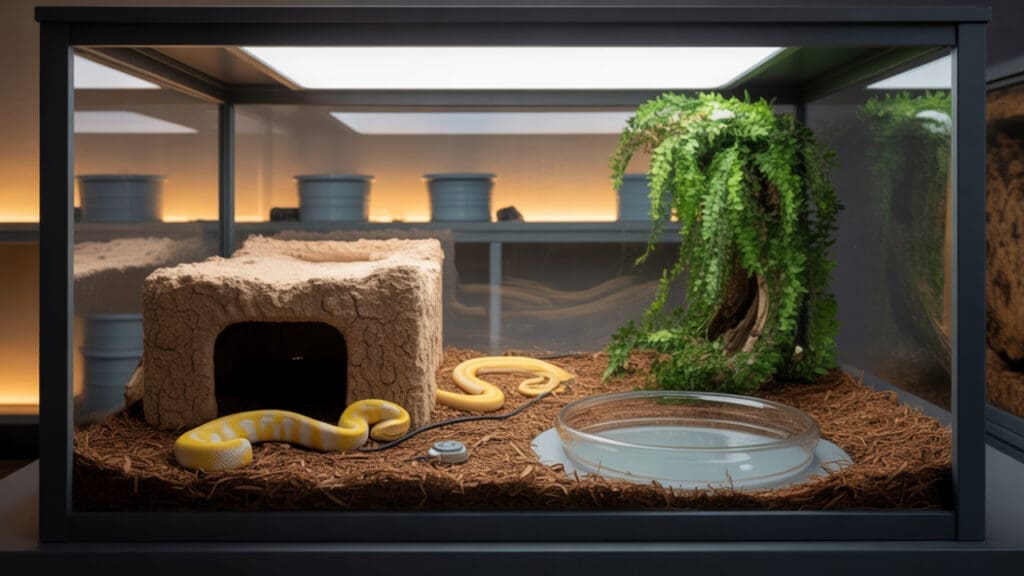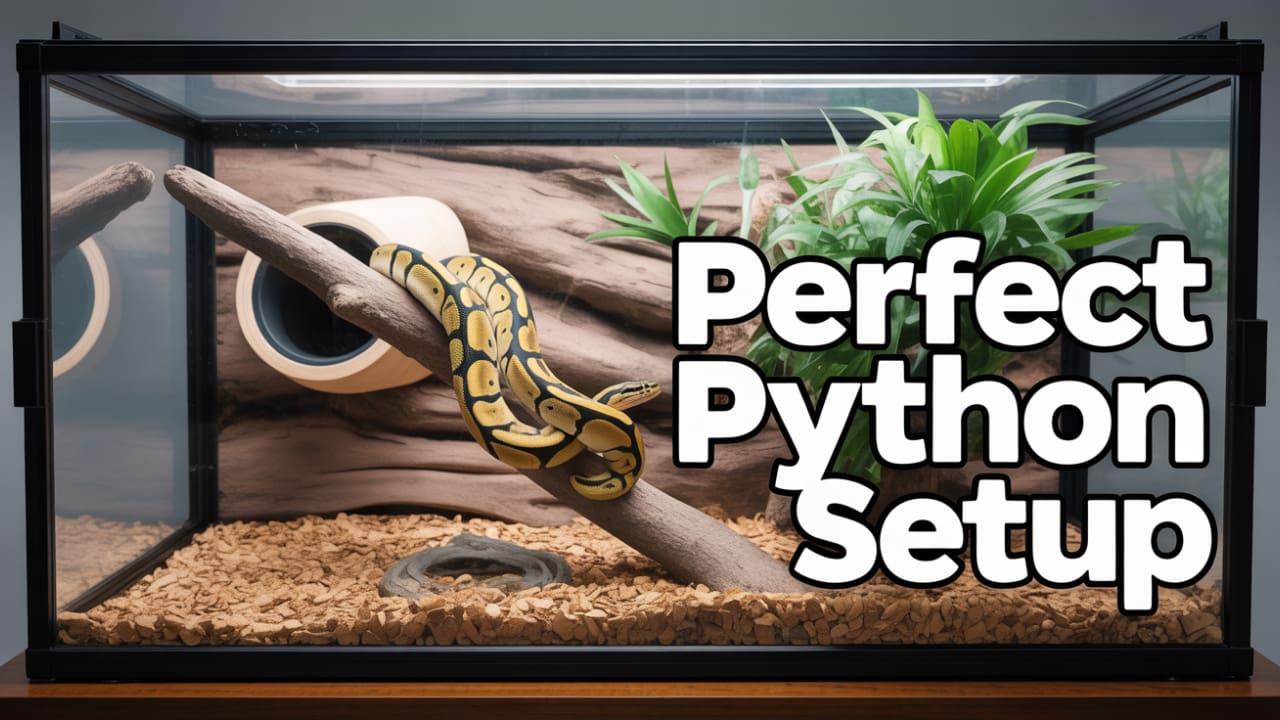Ball Python Cage Setup Guide (2025): Expert Tips on Size, Enclosure Types, Supplies, Climate Control, and Mistakes to Avoid
They are the biggest flex of your life. Your ball python, majestic and sleek, is in your enclosure. However, they’re not even eating and are always hiding. You even see them struggling to shed. Well, you might be looking at the root problem called the habitat. It’s not your snake.
A proper ball python cage setup has to be secure and escape-proof. There’s a precise heating requirement of around 88–92°F on the warm side of the enclosure. And you’ll need to keep the humidity level precisely regulated.
You should have at least two hides (for different purposes) for your ball python. Each one should be placed at the opposite ends of the enclosure. They help your snake feel safe while thermoregulating the space.
Some of us might think that the size of the enclosure is no big deal. A 20-gallon starter tank vs a 40-gallon adult enclosure is just about space, right? Not really, if you get this wrong, you might be seeing a stressed-out python.
Other concerns involve the choice of substrate and the reliance on a heat lamp without humidity adjustments. All these mistakes can eventually lead you to make more vet visits. And that means more money needs to be spent.
So, let’s check out some ball python cage requirements. You’ll know how to balance security, climate control, and enrichment by the end of this piece.
Understanding Ball Python Cage Requirements for a Healthy Habitat

That ball python is one of the most popular pet snakes out there. But many people still get confused about how to properly set up their habitat. Know that a good ball python cage setup is the foundation of your pet snake’s health. So do pay extra attention to it.
The first thing you need to look into is the security of the enclosure. You should know that your ball python has a reputation for being an excellent escape artist. So, make sure that the cage has a locking lid or secure doors. You’ll be surprised by how your snake can fit through that impossible, tiny gap.
Temperature regulation is another important factor. Your ball python needs a thermal gradient with a warm side and a cooler side. Without this, your cold-blooded reptile friend can’t really regulate their body temperature. And you can expect them to get stressed or sick.
You’ll also need to control the humidity level. Your ball python typically needs about 60-80% humidity in their living space during the day and 80-100% at night to stay healthy.
Finally, take into account space and enrichment. Your ball python doesn’t need a massive enclosure. But you’ll still need to provide them with hide boxes, climbing branches, and substrate that would allow them to burrow. These could affect their comfort level, reducing stress and encouraging natural activity.
What Kind of Cage Does a Ball Python Need? Choosing the Right Enclosure Type

You’re probably thinking that the enclosure you’re eyeing is already the best ball python cage setup there is. But hold your horses. Let’s take a look at some factors to consider before you start emptying your wallet.
The three most common options you can find out there are glass tanks, PVC cages, and tub setups. Each has its own perks and drawbacks.
You can easily find glass tanks in most shops, and they are also quite affordable. This enclosure type is also popular for beginners. However, know that glass tanks can lose heat and humidity quickly. So, you’ll have to monitor and make adjustments.
Now, experienced keepers would usually go for PVC cages. These enclosures can retain heat and moisture a lot better. They are lightweight and quite easy to clean. That said, PVC cages are more expensive than glass tanks.
If you have limited space, then tube setups might suit you best. These are budget-friendly, stackable, and easy to maintain. But of course, they aren’t really appealing to your eyes.
Remember, do not choose an enclosure for your snake based on price alone. Reptile specialists say that you’ll need one that does not cause much humidity fluctuation. This could ultimately lead to health problems in your python, like respiratory infections.
You can try a hybrid solution if you’re on a budget. For instance, you can modify a sturdy glass tank with insulated panels, upgrade the lid to reduce heat loss, and add moisture-retaining substrate. It should hold until you can get your reptile pal a premium enclosure.
Determining the Proper Cage Size for Juvenile and Adult Ball Pythons

Housing your ball python properly should be one of your priorities as their pet parent. And you should know that the size of the enclosure matters more than you think. It should be a good living space, enough for exploration and thermoregulation. So, what size cage do ball pythons need?
A juvenile ball python is roughly about 20-25 inches long. So, a 20-gallon enclosure is typically sufficient for housing one. This size is good enough for proper heating gradients. And it should be quite easy for you to monitor.
Note that while this size is cozy enough for a young snake, experts recommend we make an upgrade when their body length exceeds the enclosure’s length by 1.5 times. A baby ball python cage setup won’t be able to house them well, otherwise.
As for your adult ball python, they are around 36-48 inches long. So, they’ll need an enclosure of at least 40 gallons in size. But it’s best to go bigger. You should know that you’ll have to furnish the space properly with hides, climbing branches, and maybe even visual barriers.
Reptile vets say that a well-structured 4-foot enclosure can support your snake’s physical health and stimulate their natural behaviors. As a result, you’ll likely be able to see your python being more active and responsive.
Make no mistake, however. Bigger doesn’t always mean better. If your tank is oversized and empty, your python can feel vulnerable. So, make sure that you fill most of the space with hides, foliage, and décor. Think comfort and enrichment rather than just size and space alone.
Essential Supplies for a Complete Ball Python Cage Setup
Now that you’ve got the right enclosure type in the proper size, you should move on to the equipment. Know that these are necessary for building a miniature ecosystem for your snake to thrive in.
The top thing to consider is heating equipment. You can opt for a heat mat, heat tape, or ceramic heat emitter. They all work. But remember to pair them with a reliable thermostat. Without one, the temperature in the enclosure can fluctuate dangerously. And your snake might get burns or develop respiratory illness.
The next thing is hides. You’ll need at least two of these, placed on opposite ends of the enclosure. Make sure to align them with warm and cool sides. They are meant to give your snake a secure retreat, and this should help in regulating their stress level.
You’ll also need a hygrometer and thermometer. These are necessary for you to monitor the environment your ball python is living in. Digital models are more precise, by the way. And they usually last longer than those stick-on gauges.
As for the base of the enclosure, you’ll need to fill it with a safe substrate. Try aspen shavings, cypress mulch, or coconut fiber. You should avoid pine or cedar, as their oils can be toxic to your snake.
If you’re short on money, try something budget-friendly like blending coconut fiber with sphagnum moss. It can help boost moisture retention. Be careful and check the quality of any ball python cage setup kits you want to buy, as well.
Step-by-Step Guide: How to Set Up a Ball Python Cage
You’ll need a systematic approach in order to create a great ball python habitat. Don’t rush or skip steps. You want to make sure that your snake gets the best environment you can possibly offer. And this can lead to a healthy and stress-free reptile companion. Let’s check out the necessary steps to take.
Step 1: Prepare the enclosure. You should thoroughly clean and disinfect the enclosure. Use a reptile-safe cleaner and remove any residues from manufacturing or previous use (maybe it’s a second-hand purchase). This is both a good sanitary starting point and it prevents bacterial growth.
Step 2: Install heating equipment. Make sure to place a heat mat or heat tape under one side of the closure. Don’t forget to connect it to the thermostat, and position a thermometer probe right above the heat source. The warm side is now ready. Know that it is important to maintain your snake’s belly heat for digestion.
Step 3: Add substrate and hides. You can spread the substrate you’ve chosen now. Even it out. After that, place at least two hides, one on the warm side of the enclosure and one on the cool side. Your snake can choose which side is more comfortable for them.
Step 4: Set up water and décor. Add a water dish. It should be sturdy and large enough for soaking. Then, arrange the branches, artificial plants, and any decor items you’ve bought. Make sure to create enough cover and climbing opportunities.
Step 5: Test and adjust. Check and see for the next 24-48 hours. Double-check and see if everything’s running properly before introducing your snake. Is the temperature consistent? What about the humidity level? Make adjustments if you need to during this “dry run.”
Quarantine vs. Forever Home: Protecting Your Snake’s Health
Before moving your ball python into its permanent, fancy enclosure, it must spend at least 3 months in quarantine. This simple setup helps you:
- Monitor its health
- Ensure it’s eating properly
- Prevent parasites or diseases from spreading to your other reptiles
Why Quarantine Matters
Even snakes from reputable breeders can carry hidden health issues. Some problems, like mites, respiratory infections, or internal parasites, may not show symptoms right away. Quarantine keeps your main collection safe while giving your new snake a healthy start.
Quarantine Setup Basics
- Enclosure: Use a sterilizable storage tub (33-quart or larger for adults). Function over looks-it’s about health, not decoration.
- Substrate: Paper towels only. Easy to clean, spot parasites, and monitor droppings. Avoid towels or rags-they can harbor bacteria or be eaten.
- Temperature: Maintain a gradient: 88–92°F warm side, 78–80°F cool side. Use an under-tank heater with a thermostat.
- Décor: Minimal-just two hides (warm and cool) and a water bowl. No porous items that can’t be disinfected.
Quarantine Duration
- Minimum: 90 days (widely recommended by vets and zoos)
- Longer: Some keepers quarantine for 6–12 months for valuable collections
- Important: The quarantine clock resets if you add a new reptile or notice any illness
Keep Everything Separate
- Use different tools, tongs, cleaning supplies, and thermometers for quarantine vs. established snakes.
- Always handle your established animals first, then quarantine snakes last.
It might not look fancy, but a proper quarantine could save your snake’s life-and protect your other reptiles too.
Temperature, Humidity, and Lighting Control in a Ball Python Tank
Now, let’s zoom in a little more on the climate suitable for your ball python. It’s very important for long-term care. Your reptile companion will need an environment that closely mimics conditions in the wild to thrive, after all.
Let’s start with temperature regulation. Your ball python tank should have a thermal gradient, warm and cool. The warm side should be between 88°F and 92°F. It is meant to help support your snake’s digestion. The cold side, on the other hand, should be between 78°F and 80°F so that your pet can rest comfortably. Having both sides is important for your python to self-regulate their body temperature.
Humidity is just as important for your snake companion. You should try to make sure that it is 50–60% under normal conditions. If they are shedding, however, adjust it up to 70%. You don’t want your little one to struggle with stuck sheds. But be careful not to have too much humidity, as it can give rise to mold and respiratory problems.
The last thing to watch out for is lighting. Your ball python may not need UVB like some other reptiles. But it’s great to have a consistent day-night cycle for them. You can also introduce low-intensity LED or fluorescent lighting on a timer. They can help maintain your snake’s circadian rhythm.
Heating & Lighting: The 2025 Science-Based Guide for Ball Pythons
Modern ball python care has moved past old “pet rock” ideas. Here’s what the latest research and expert consensus say about heating.
Overhead Heat vs. Under-Tank Heat
| Feature | Under-Tank Heater (UTH) | Overhead Heater (Ceramic Heat Emitter / DHP) |
| Best For | Provides belly heat to aid digestion | Creates natural air and surface temperature gradients |
| Humidity Impact | Minimal effect | Can lower humidity, so monitor closely |
| Safety | Must use thermostat to prevent burns | Also needs thermostat; stays hot after turning off |
| Expert Opinion (2025) | Good supplement, but shouldn’t be the only heat source | Preferred primary method—heats air and surfaces naturally |
Key Takeaways
- Overhead heating is superior.
- UTHs struggle with thick substrates and can be fire hazards.
- Ceramic heat emitters (CHEs) provide a more natural temperature gradient and use less energy than heat lamps.
- UTHs struggle with thick substrates and can be fire hazards.
- Optimal Setup:
- Use a 75–100 watt CHE positioned about 12 inches (30 cm) above the basking spot, controlled by a thermostat.
- Use a 75–100 watt CHE positioned about 12 inches (30 cm) above the basking spot, controlled by a thermostat.
Add a UTH only if extra belly heat is needed.
The UVB Revolution: 2025 Best Practices for Ball Pythons
Old Myth
“Ball pythons don’t need UVB.”
2025 Evidence-Based Approach
Recent research shows UVB is more than just vitamin D3 synthesis—it benefits immune function, natural behavior, coloration, and overall well-being. Wild ball pythons are sensitive to UV light and get UVB naturally through shaded basking.
Current UVB Recommendations
- Bulb Type: T5 HO fluorescent tubes
- Arcadia Forest 6% or Zoo Med ReptiSun 5.0
- Length: 22–24 inches
- Arcadia Forest 6% or Zoo Med ReptiSun 5.0
- Placement: Under a mesh screen (not over it) to avoid UVB blocking
- Distance from Snake: 18–24 inches
- Replacement: Every 12 months, even if the bulb still emits light
Why It Matters: UVB is no longer optional—it’s part of modern, high-quality ball python care.
Temperature Precision: Beyond Surface Readings
Critical Insight: Surface temperature readings can be misleading. For example: a slate vs. wood surface may show different temps, but deliver the same infrared heat to your snake.
Better Method:
- Use the “tingly hand test”: place your hand under the heat source. It should feel warm and tingly, not scorching.
- Monitor your python’s behavior: proper basking is 10–30 minutes in the morning and evening. Constant basking or complete avoidance signals the setup may need adjustment.
Substrate, Décor, and Enrichment for Comfort and Stimulation
Let’s take a closer look at some ball python cage ideas to create a great environment for your little companion. This could mimic natural conditions and encourage your snake’s instinctive behaviors.
For substrate, choose aspen shavings, cypress mulch, or coconut fiber, as they can retain humidity well. Plus, they allow your snake to burrow well. Remember to avoid pine and cedar, as their aromatic oils can be toxic to reptiles. If premium substrates are too expensive, try some budget-friendly blends by mixing coconut fiber with sphagnum moss.
Now, decor is more than just aesthetics. Your ball python needs their hides, of course. Branches, climbing structures, and artificial plants can cover (privacy) and encourage your snake to explore the enclosure. Even though your python might not be a famous climber, having some opportunities for doing so can make them active and reduce their stress level.
Lastly, pay attention to enrichment. You can simply make changes like rotating decor or adding different textures to break the monotony. You can even try introducing scent trails (safe, non-toxic items) to spark curiosity in your snake. Some owners also provide many different hide types for security and stretching.
FAQs About Ball Python Cage Setup
You’re probably still a little overwhelmed regarding creating a ball python cage setup. No worries, we’ve got you. Let’s take a look at some frequently asked questions and the answers backed by expert caretakers.
1. What does a ball python need in its cage?
You should make sure that the enclosure is secure. Add a heat source with a thermostat and hides on both the warm and cool sides of the enclosure. Other than that, you’ll need to supply a water dish, safe substrate, and control the humidity levels using a hygrometer.
2. What is the recommended cage size for a ball python?
Your juvenile snake can do well in 20-gallon tanks. Adult pythons, however, should have at least a 40-gallon enclosure or a cage. They are about 36–48 inches long, after all. You shouldn’t go overboard with too much empty space without hides.
3. Do ball pythons need a heat lamp or heat pad?
It’s best to have heat pads or heat tape to keep your snake’s belly warm. They do replicate natural heat sources well. You can use heat lamps, but you’ll need to manage humidity more closely or often.
4. Can I leave the heat lamp on all night for a ball python?
You can use a heat lamp overnight if it’s not a bright light. Remember that light can disrupt your snake’s day-night cycle. Try ceramic heat emitters. They are a great substitute for nighttime heat.
5. How cold is too cold for a ball python?
Take note that temperatures below 75°F (24°C) can be dangerous for your reptile field. If your snake is exposed to cold for a long time, they may develop digestive problems and respiratory illness.
6. What kind of substrate is best for a ball python cage?
You can use aspen shavings, coconut fiber, and cypress mulch. These are safe and moisture-retaining choices. Remember to avoid pine and cedar because of their harmful oils.
7. How do I maintain humidity in a ball python’s enclosure?
You should mist the enclosure lightly. Use moisture-retaining substrate and position the water bowl on the warm side of the enclosure. This should help keep the levels between 50–60%.
8. Why is a hide important in a ball python cage?
Hides give your snake a secure retreat. So, they help reduce their stress. They are also important for feeding, shedding, and overall comfort.
9. Can ball pythons live in a glass tank?
Yes, but you’ll need to monitor and adjust the humidity level carefully. Know that glass tends to lose moisture faster than PVC or tubs.
10. How often should I clean a ball python’s cage?
Do spot cleaning every day and deep cleaning every 4–6 weeks. During deep cleaning, replace the substrate and disinfect the decor and surfaces with reptile-safe products.
How Do You Create the Best Ball Python Cage Setup?
You probably understand why that enclosure is such a big deal now. A secure enclosure is basically a ticket to having a thriving ball python in your care.
Remember, choose the right size for your snake’s life stage. Provide and maintain heat of between 88–92°F on the warm side of the enclosure. Also, don’t forget that the humidity level sound stays within the 50–60% sweet spot.
You should also know now what common mistakes to avoid. For example, it’s not good to just use one hide, and ignoring temperature and humidity might affect your snake’s physical and mental health.
So, apply the knowledge you’ve gained. You’re ready to create a great habitat to support your ball python’s life. Both you and your reptile friend deserve years of long companionship.
What’s your trick to keeping your ball python’s enclosure perfect? Share your advice in the comments down below!








